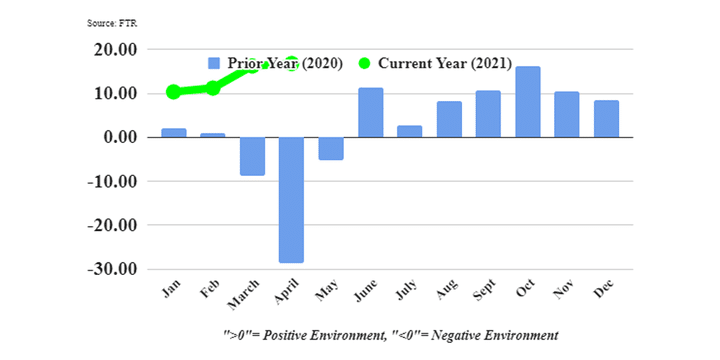Transfix Take Podcast: Episode 2
Short-Lived Calm Before Summer Storm
Tender rates, rejections and volume reversed slightly in the past week, but they still are at extremely elevated levels, allowing shippers and brokers to take a much-needed breath in what seemed like a never-ending climb upward. We are still seeing very slim week-over-week increases in average rates nationally, heavily driven by the major freight hubs’ continual battle for capacity.
“This week, markets near the southern U.S. border (Texas, Louisiana, Mississippi, Arkansas) and Southern California will be the tightest,” says Justin Maze, Transfix’s senior manager of carrier account management. “Georgia has shown some signs of cooling off, but this will be short-lived, as the state heads into its peak season and deals with ongoing record imports into Savannah. California and coastal markets are the areas to watch in the coming months, as we gear up for a potentially record-breaking import period similar to what we saw last year. The Midwest and Northeast still show pockets of looseness.
“Looking down the road, we see signs of months of elevated and record-breaking imports. We are already seeing signs of rising volume on the West Coast, but this has not yet translated into longer hauls. Most likely, we will see more imports spread among the U.S. ports, which could bring elevated volumes to markets on both coasts.”
Container spot rates are setting records, not only from Asia to the West, but also from Asia and Europe to the East. Empty containers heading back to Asia continue to rise to levels never before seen, as carriers push to get them back.
According to Brendan Murray for Bloomberg.com, Dan Maffei, chair of the Federal Maritime Commission, believes “stretched global supply chains pushing ocean-freight rates to record highs may stay strained into 2022, raising concerns about whether small American companies can weather another year of a tangled transport system and much higher costs.”
“U.S. ports are struggling to work through bottlenecks of goods imported on container ships, while the rail and truck networks that disperse them across the country are strained with equipment and labor shortages,” Murray writes. “The supply snarls are colliding with a surge in demand for goods, as the world’s largest economy heads for peak shipping season — July and August — when retailers build inventories heading into the year-end holidays.”
April Trucking Conditions Reach Record High
FTR reported this week that its Trucking Conditions Index (TCI) for April achieved a record-high reading of 16.82, surpassing the previous all-time high of 16.17 in March. The TCI tracks changes representing five major conditions in the U.S. full-load truck market that influence fleet behavior: freight volumes, freight rates, fleet capacity, fuel price and financing. A reading above zero indicates “good, optimistic conditions.”

Source: FTR
“Although most market factors were not quite as strong in April as they were in March, a reversal of March’s higher diesel prices improved overall trucking conditions,” FTR reports. “The relief in fuel costs was short-lived, but FTR expects solid freight demand coupled with high capacity utilization and robust freight rates to keep the TCI quite strong in the near term and at least in positive single digits well into 2022 and perhaps beyond.”
“… Given robust competition for labor — job openings in the economy are at an all-time high — trucking’s capacity challenge could linger longer than usual,” says Avery Vise, FTR’s vice president of trucking. “One signal we are watching closely is the spot market. If rates and volumes begin to ease, that could indicate a balancing of freight demand and route guide capacity.”
With the uncertainty and volatility surrounding the U.S. economic recovery, shippers need a partner that can help them adapt and excel — no matter the circumstance. Shippers turn to Transfix for our leading technology and reliable carrier network. As volumes drive higher, we are here to help: Learn more about our Core Carrier program and Dynamic Lane Rates. As part of our ongoing market coverage, we’ll continue to provide breaking news, resources and insight into emerging trends and the pandemic’s impact on the transportation industry.



